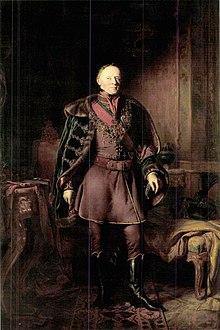|
Paul III Anton, Prince Esterházy
Paul III Anton, Prince Esterházy (German: Paul Anton Esterházy von Galantha; 11 March 1786 – 21 May 1866) was a Hungarian prince, a member of the famous Esterházy family. He was the son of Prince Nikolaus II and succeeded his father on the latter's death in 1833. The basis of his wealthFor several generations, the Esterházy family had been exceedingly wealthy. The wealth came from their extensive landholdings, mostly in Hungary. In 1848, the American author John Stevens Cabot Abbott wrote the following of him: 
The Prince's wealth came partly from the great number of peasants who owed him a portion of the fruits of their labours. He also had his own enterprises, directed by his staff, notably sheep raising. Of his enormous flock, Abbott relates:
Despite his great wealth, Paul managed to spend beyond his means, getting into financial trouble just as his father had. According to the Encyclopædia Britannica Eleventh Edition, "the last years of his life were spent in comparative poverty and isolation, as even the Esterházy-Forchtenstein estates were unequal to the burden of supporting his fabulous extravagance and had to be placed in the hands of curators."[2] His successor Nikolaus III got out of debt in part by selling the famous family art collection. Career as diplomat and politician While most of Paul's ancestors had served the Empire as military officers, Paul instead pursued a career in diplomacy, and later politics. In 1806 he was secretary of the embassy in London, and in 1807 worked with Metternich in the same capacity in Paris. In 1810 he was accredited to the court of Dresden, where he tried in vain to detach Saxony from Napoleon, and in 1814 he accompanied his father on a secret mission to Rome. He took a leading part in all the diplomatic negotiations consequent upon the wars of 1813–1815, especially at the Congress of Châtillon.[2] After the Congress of Vienna (1815) he was appointed as ambassador to the United Kingdom at the request of the Prince Regent. His wife Maria Theresia became extremely popular in London, and was a patroness of Almack's club, the centre of fashionable society. In 1824 he represented Austria as ambassador extraordinary at the coronation of Charles X of France, and was the premier Austrian commissioner at the London conferences of 1830–1836.[2]  In 1842 Paul returned to Hungary and became a member of the Conservative Party, which supported the Habsburg supremacy and did not favour the reform experiments. On 7 April 1848 he was appointed as Minister beside the King in the first cabinet of Hungary which was controlled by Count Lajos Batthyány. His role was as the mediator between Vienna and the Hungarian government. Seeing that his pacifying intentions ended in failure, he resigned from his position in September. Later Esterházy took connections with the immigrated politicians. He was Minister besides the King during the Hungarian Revolution of 1848. At the time of the Napoleonic Wars, he worked for the Austrian Empire as a diplomat. He tried to form diplomatic associations for Vienna, (for example with the Kingdom of Saxony), but he did not achieve any results. Despite this failure, Esterházy remained a famous and acknowledged politician. NotesReferences
|
||||||||||||||||||||||||||||
